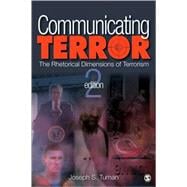
Note: Supplemental materials are not guaranteed with Rental or Used book purchases.
Purchase Benefits
What is included with this book?
| Introduction | |
| The Struggle to Define Terrorism | |
| Defining Terrorism | |
| Attempts to Synthesize a Consensus Definition | |
| Summary | |
| Notes | |
| Terrorism as a Communication Process With Rhetorical Dimensions | |
| Terrorism as a Communication Process | |
| Terrorism and Rhetoric | |
| Summary | |
| Notes | |
| Labeling and Defining Terrorism as Rhetoric | |
| Definitions and Labels | |
| Reconsidering the Definition of Terrorism | |
| Summary | |
| Notes | |
| Symbols, Symbolism, and Terrorism: Means and Implements | |
| Symbols, Symbolism, and Violence/Destruction | |
| Symbolism in the Implements and Tools of Terrorism | |
| Summary | |
| Notes | |
| Symbolism in the Targets of Terrorism | |
| Temporal Targets for Terrorism | |
| Symbolism in the Chechen Terrorist Attack on a Moscow Theater | |
| Symbolism, the World Trade Center, and the Pentagon | |
| Summary | |
| Notes | |
| Methods for Studying Public Oratory About Terrorism | |
| A Method of Rhetoric for Public Oratory | |
| Summary | |
| Notes | |
| Case Studies for Public Oratory About Terrorism | |
| President Bush's Speech to the Nation Immediately After the Attacks of 9/11 | |
| President Bush's Speech to the Congress, the Nation, and the World on September 20, 2001 | |
| Speech by Osama bin Laden, Dated 11/1/2004: Just Before the 2004 General Election in the United States | |
| Summary | |
| Notes | |
| Theories of Mass Media for Terrorism | |
| Understanding Mass Media | |
| Media-Centered Criticism | |
| Summary | |
| Notes | |
| Mass-Mediated Images and Construction of Terrorism | |
| Terrorism From Above and Mass Media | |
| Terrorism From Below and Mass Media | |
| Agenda Setting and the Framing of Terrorism in News Media | |
| Terrorism and New Media | |
| Terrorism and Paid Media | |
| Summary | |
| Notes | |
| Index | |
| About the Author | |
| Table of Contents provided by Ingram. All Rights Reserved. |
The New copy of this book will include any supplemental materials advertised. Please check the title of the book to determine if it should include any access cards, study guides, lab manuals, CDs, etc.
The Used, Rental and eBook copies of this book are not guaranteed to include any supplemental materials. Typically, only the book itself is included. This is true even if the title states it includes any access cards, study guides, lab manuals, CDs, etc.